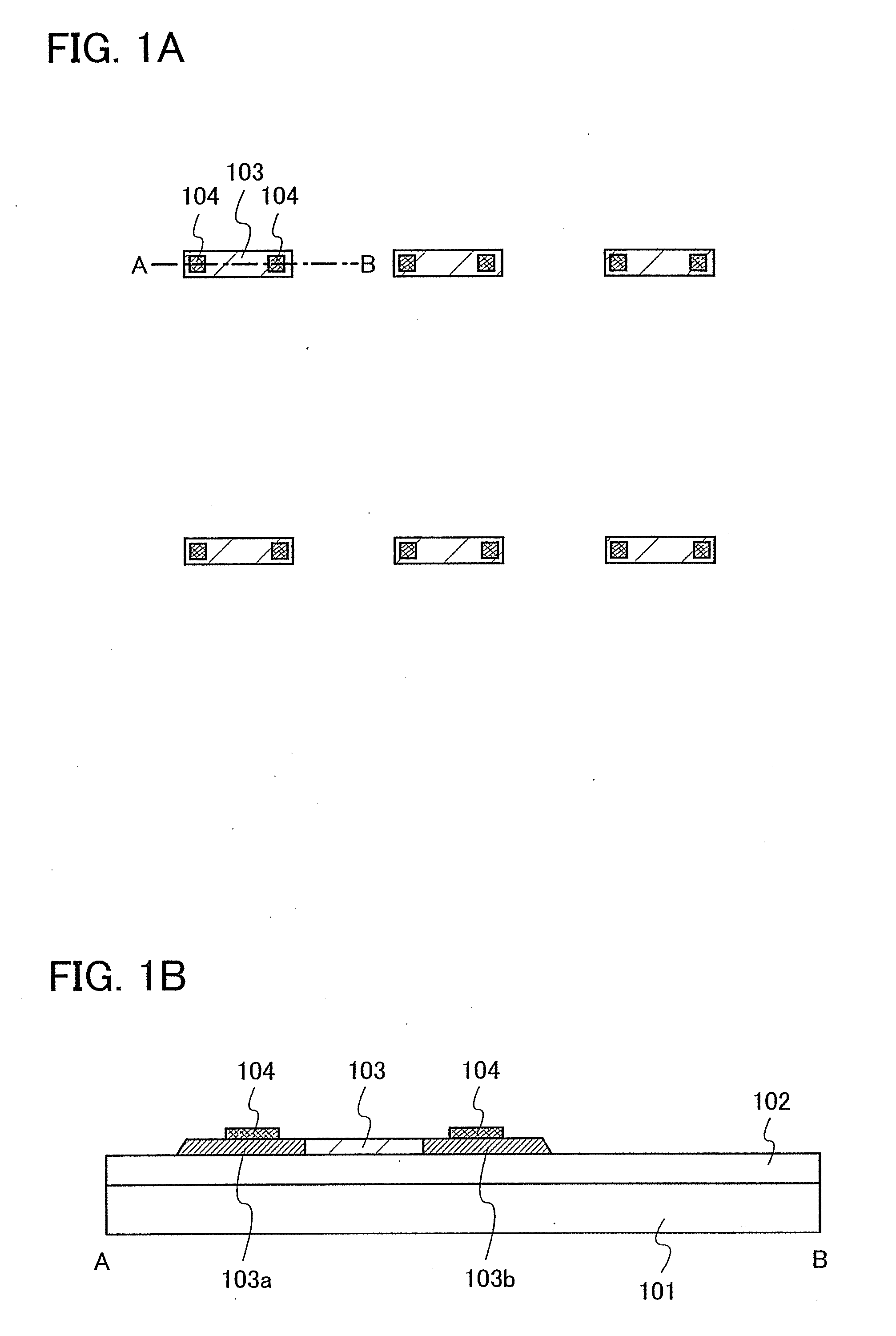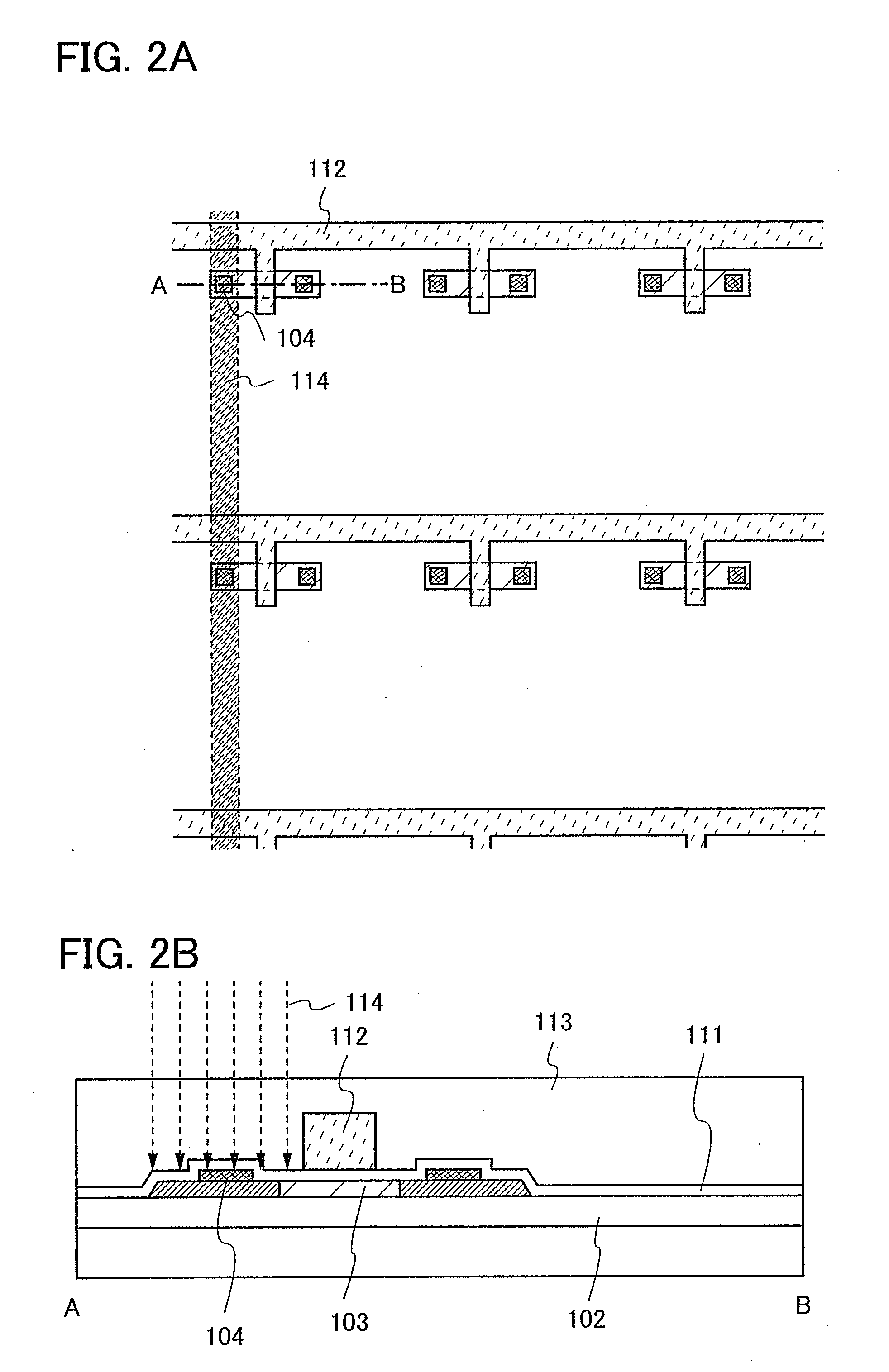Method for Manufacturing Semiconductor Device
a manufacturing method and semiconductor technology, applied in the direction of semiconductor devices, basic electric elements, electrical appliances, etc., can solve the problems of monetary burden but also time delay risk, extreme cost, and inability to manufacture, so as to reduce the time loss due to the replacement of photomasks, and reduce the cost of manufacturing
- Summary
- Abstract
- Description
- Claims
- Application Information
AI Technical Summary
Benefits of technology
Problems solved by technology
Method used
Image
Examples
embodiment mode 1
[0048]In this embodiment mode, a LAP (Laser Ablation Process), in which an opening portion is formed by laser beam irradiation without undergoing a photolithography step, is shown hereinafter. FIGS. 1A to 5B are top views and cross-sectional views showing a step of forming an opening portion in an insulating layer formed over a substrate, in a pixel portion in which pixels each including a display element are arranged in matrix. FIGS. 1B, 2B, 3B, 4B, and 5B show cross-sectional views taken along lines A-B of FIGS. 1A, 2A, 3A, 4A, and 5A, respectively.
[0049]In this embodiment mode, description is made with reference to a mode in which a top-gate thin film transistor is used as a thin film transistor that is part of a display element and an opening portion is formed in an insulating layer formed over a semiconductor layer of the thin film transistor. However, the present invention is not limited to this and is appropriately applicable to a mode in which an opening portion is formed in...
embodiment mode 2
[0104]This embodiment mode describes a method for forming an opening portion in an insulating layer formed over a substrate by a process different from that in Embodiment Mode 1 in a pixel portion in which pixels each including a display element are arranged in matrix, with reference to FIGS. 6A to 10B. This embodiment mode is different from Embodiment Mode 1 in a step of removing a light absorbing layer by a laser beam. FIGS. 6A to 10B are top views and a cross-sectional views each illustrating a step of forming an opening portion in an insulating layer formed over a substrate. FIGS. 6B, 7B, 8B, 9B, and 10B show cross-sectional views taken along lines A-B in FIGS. 6A, 7A, 8A, 9A, and 10A, respectively.
[0105]In this embodiment mode, description is made with reference to a mode in which a plurality of light absorbing layers in a direction intersecting with a source wiring is irradiated with a linear laser beam in a pixel portion in which pixels which each include a display element ar...
embodiment 1
[0122]In this embodiment, a liquid crystal display device which is an example of a semiconductor device is described with reference to FIGS. 11A to 11C.
[0123]As shown in FIG. 11A, thin film transistors 225 to 227 are formed over a substrate 101. As a method for forming an opening portion which connects wirings 234 to 239 of the thin film transistors 225 to 227 and a semiconductor film, the above-described embodiment mode can be employed. In this embodiment, each gate electrode of the thin film transistors 225 to 227 is formed to have a two-layer structure. Here, after a tantalum nitride film with a thickness of 30 nm and a tungsten film with a thickness of 370 nm are formed over the gate insulating film by a sputtering method, a resist mask formed by a photolithography step is used to etch the tantalum nitride film and the tungsten film selectively, and the gate electrodes each having a shape that an end portion of the tantalum nitride film extends out farther to the outside than an...
PUM
 Login to View More
Login to View More Abstract
Description
Claims
Application Information
 Login to View More
Login to View More - R&D
- Intellectual Property
- Life Sciences
- Materials
- Tech Scout
- Unparalleled Data Quality
- Higher Quality Content
- 60% Fewer Hallucinations
Browse by: Latest US Patents, China's latest patents, Technical Efficacy Thesaurus, Application Domain, Technology Topic, Popular Technical Reports.
© 2025 PatSnap. All rights reserved.Legal|Privacy policy|Modern Slavery Act Transparency Statement|Sitemap|About US| Contact US: help@patsnap.com



